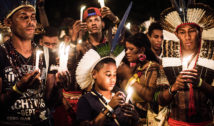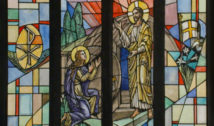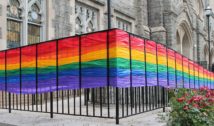
Oklahoma State Supreme Court Echoes Madison and Jefferson In Nixing Taxpayer-Funded Religious Charter School
- By Deirdre Pelphrey --
- 03 Jul 2024 --
It would have been—and still could be—the first taxpayer-funded religious public school in America, representing not one small step but a giant leap across the wall separating church and state.
St. Isidore of Seville Catholic Virtual School, a proposed online Catholic charter school—a type of public school—financed not by families paying tuition but by the people of Oklahoma, was scheduled to open for business this August. It hit a roadblock: the Oklahoma State Supreme Court. On June 24, the court ruled by a 6-2 vote that allowing a religious charter school would violate the state constitution and that “Enforcing the St. Isidore contract would create a slippery slope.”
The slippery slope here is not just a local issue but a national one that could shape the future of religious education. If the government were to fund religious instruction, taxpayers of all faiths—Jewish, Muslim, LDS, Buddhist, or any other—could be mandated to contribute to faiths with tenets other than their own.
The Catholic archbishop of Oklahoma City, Paul S. Coakley, and the bishop of Tulsa, David A. Konderla, expressed their disappointment with the ruling. However, they also made it clear that they are not giving up. They stated, “We will consider all legal options and remain steadfast in our belief that St. Isidore would have and could still be a valuable asset.”
One significant legal recourse, perhaps inevitable, is the U.S. Supreme Court. The high court could set a national precedent with its conservative majority showing a willingness for government involvement in religious schools. In 2020 and 2022, the court ruled that private or religious schools in Montana and Maine must be included in any government-funded tuition or scholarship program—effectively allowing the state to sponsor religious education.
St. Isidore supporters feel religious charter schools should enjoy the same governmental funding and are eager for the Supreme Court to review the case.
Oklahoma’s Attorney General, Gentner Drummond, successfully argued against the constitutionality of the school’s creation before the state Supreme Court.
“Make no mistake, if the Catholic Church were permitted to have a public virtual charter school, a reckoning will follow in which this state will be faced with the unprecedented quandary of processing requests to directly fund all petitioning sectarian groups,” the lawsuit stated.
The Attorney General’s lawsuit also contended that the school board’s action could jeopardize more than $1 billion in federal education funding the state receives in exchange for complying with federal mandates prohibiting a publicly funded religious school.
“Not only is this an irreparable violation of our individual religious liberty, but it is an unthinkable waste of our tax dollars,” Drummond said.
“It’s hard to think of a clearer violation of the religious freedom of Oklahoma taxpayers and public-school families than the state establishing the nation’s first religious public charter school,” Rachel Laser, the president and CEO of Americans United for Separation of Church and State, said last summer when the Oklahoma Statewide Virtual Charter School Board first approved St. Isidore’s existence as a religious charter school. “This is a sea change for American democracy.”
Government support of religious instruction as a bone of contention is not new in America. What is happening in Oklahoma and other states, such as Louisiana, where the Ten Commandments are now required to be posted in every public classroom from kindergarten through college, echoes a similar issue the young nation faced 240 years ago. In 1784, in a crucial test of religious freedom, Patrick Henry introduced a general assessment tax in the new state of Virginia to support “Teachers of the Christian Religion.”
That proposed tax was similar to what the state of Oklahoma would have compelled its citizens to do, no matter their faith: to finance Christian instruction. James Madison, recognizing the danger of blurring the lines of religion and state, penned an essay, “Memorial and Remonstrance Against Religious Assessment,” in opposition to Henry’s bill,
In it, Madison argued, “Who does not see that the same authority which can establish Christianity, in exclusion of all other Religions, may establish with the same ease any particular sect of Christians, in exclusion of all other Sects? That same authority which can force a citizen to contribute three pence only of his property for the support of any one establishment, may force him to conform to any other establishment in all cases whatsoever.”
Madison’s argument moved many and won the support of minority Christian sects such as Baptists and Presbyterians, who felt threatened by government favoritism of the dominant sect in Virginia, Anglicanism. Ultimately, Henry’s bill was voted down, which paved the way for the Virginia Statute for Religious Freedom, authored by Madison’s close friend Thomas Jefferson. The Statute for Religious Freedom, approved by the Virginia Assembly in 1786, sealed the deal of separation of church and state and was the basis for the First Amendment of the Bill of Rights five years later.
The Statute addresses the lawmakers of Oklahoma, Maine and Montana two centuries hence who mandated taxpayer support of religious education when it states, “that to compel a man to furnish contributions of money for the propagation of opinions which he disbelieves, is sinful and tyrannical.”
Those, therefore, who wish to invite, include and involve government footprints in religion may well take heed of Jefferson’s warning at the conclusion of the Virginia Statute for Religious Freedom: “yet we are free to declare, and do declare, that the rights hereby asserted are of the natural rights of mankind, and that if any act shall be hereafter passed to repeal the present, or to narrow its operation, such act shall be an infringement of natural right.”
Photo credits: OKC Supreme Court Entrance by Serge Melki. CC BY 2.0.



















